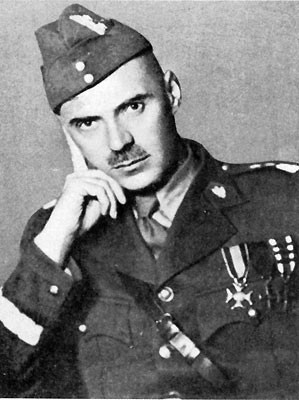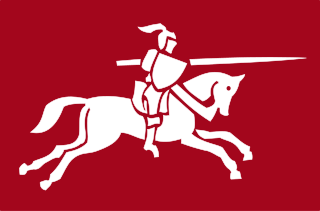
I Corps was an army corps in existence as an active formation in the British Army for most of the 80 years from its creation in the First World War until the end of the Cold War, longer than any other corps. It had a short-lived precursor during the Waterloo Campaign. It served as the operational component of the British Army of the Rhine during the Cold War, and was tasked with defending West Germany.

The 21st Army Group was a British headquarters formation formed during the Second World War. It controlled two field armies and other supporting units, consisting primarily of the British Second Army and the First Canadian Army. Established in London during July 1943, under the command of Supreme Headquarters Allied Expeditionary Force (SHAEF), it was assigned to Operation Overlord, the Western Allied invasion of Europe, and was an important Allied force in the European Theatre. At various times during its existence, the 21st Army Group had additional British, Canadian, American, and Polish field armies or corps attached to it. The 21st Army Group operated in Northern France, Luxembourg, Belgium, the Netherlands and Germany from June 1944 until August 1945, when it was renamed the British Army of the Rhine (BAOR).

The 2nd Polish Corps, 1943–1947, was a major tactical and operational unit of the Polish Armed Forces in the West during World War II. It was commanded by Lieutenant General Władysław Anders and fought with distinction in the Italian Campaign, in particular at the Battle of Monte Cassino. By the end of 1945, the corps had grown to well over 100,000 soldiers.

XXX Corps was a corps of the British Army during the Second World War. The corps was formed in the Western Desert in September 1941. It provided extensive service in the North African Campaign and many of its units were in action at the Second Battle of El Alamein in late 1942. It then took part in the Tunisia Campaign and formed the left flank during the Allied invasion of Sicily in 1943.

VIII Corps was a British Army corps formation that existed during the First and Second World Wars. In the latter, it took part in the Normandy Campaign in 1944, where it was involved in Operation Epsom and Operation Goodwood. It would later play a supporting role in Operation Market Garden and finish the war by advancing from the Rhine to the Baltic Sea.

The 1st Canadian Division is a joint operational command and control formation based at CFB Kingston, and falls under Canadian Joint Operations Command. It is a high-readiness unit, able to move on very short notice, and is staffed and equipped to meet Canada's military objectives to counter any potential threat.

The 6th South African Armoured Division was the second armoured division of the South African Army and was formed during World War II. Established in early 1943, it was based on a nucleus of men from the former 1st South African Infantry Division who had returned to South Africa after the Second Battle of El Alamein in late 1942. The division was initially transferred to Egypt for training, after which it served in the Allied campaign in Italy during 1944 and 1945. In Italy, the division was initially deployed as part of the British Eighth Army, under command of Lieutenant-General Oliver Leese, and was then transferred to the U.S. Fifth Army, under Lieutenant General Mark W. Clark, for the remainder of the Italian Campaign. The division operated as a strongly reinforced division and was frequently used to spearhead the advance of the Corps and Army to which it was attached. They returned home after the end of the war in Italy and were disbanded in 1946. The division was also briefly active after the war from 1 July 1948 to 1 November 1949.

The First Army was a field army of France that fought during World War I and World War II. It was also active during the Cold War.

Operation Veritable was the northern part of an Allied pincer movement that took place between 8 February and 11 March 1945 during the final stages of the Second World War. The operation was conducted by Field Marshal Bernard Montgomery's Anglo-Canadian 21st Army Group, primarily consisting of the First Canadian Army under Lieutenant-General Harry Crerar and the British XXX Corps under Lieutenant-general Brian Horrocks.

The 11th Armoured Division was an armoured division of the British Army which was created in March 1941 during the Second World War. The division was formed in response to the unanticipated success of the German panzer divisions. The 11th Armoured was responsible for several major victories in the Battle of Normandy from in the summer of 1944, shortly after the Normandy landings, and it participated in the Allied advance from Paris to the Rhine, the Rhine crossing in March 1945. It was disbanded in January 1946 and reformed towards the end of 1950. In 1956, it was converted into the 4th Infantry Division.

The 6th Armoured Division was an armoured division of the British Army, created in September 1940 during the Second World War and re-formed in May 1951 in the UK.

The Battle of the Argenta Gap was an engagement which formed part of the Allied spring 1945 offensive during the Italian campaign in the final stages of the Second World War. It took place in northern Italy from 12 to 19 April 1945 between troops of British V Corps commanded by Lieutenant-General Charles Keightley and German units of LXXVI Panzer Corps commanded by Lieutenant General Gerhard von Schwerin.
Gothic Line order of battle is a listing of the significant formations that were involved in Operation Olive, the Allied offensive on the Gothic Line in northern Italy, August–September 1944, and in the subsequent fighting in the central Apennine mountains and on the plains of eastern Emilia–Romagna up to April 1945.

The Spring 1945 offensive in Italy, codenamed Operation Grapeshot, was the final Allied attack during the Italian Campaign in the final stages of the Second World War. The attack in the Lombard Plain by the 15th Allied Army Group started on 6 April 1945 and ended on 2 May with the surrender of all Axis forces in Italy.
Operation Diadem order of battle is a listing of the significant formations that were involved in the fighting on the Winter Line and at the Anzio bridgehead south of Rome during Operation Diadem in May - June 1944 which resulted in the Allied breakthrough at Cassino and the breakout at Anzio leading to the capture of Rome.

II Canadian Corps was a corps-level formation that, along with I (British) Corps and I Canadian Corps, comprised the First Canadian Army in Northwest Europe during World War II.

At the start of 1939, the British Army was, as it traditionally always had been, a small volunteer professional army. At the beginning of the Second World War on 1 September 1939, the British Army was small in comparison with those of its enemies, as it had been at the beginning of the First World War in 1914. It also quickly became evident that the initial structure and manpower of the British Army was woefully unprepared and ill-equipped for a war with multiple enemies on multiple fronts. During the early war years, mainly from 1940 to 1942, the British Army suffered defeat in almost every theatre of war in which it was deployed. But, from late 1942 onwards, starting with the Second Battle of El Alamein, the British Army's fortunes changed and it rarely suffered another defeat.
The Allied invasion of Italy, a phase of the Mediterranean Theater of World War II, took place on 3 September at Reggio di Calabria, and on 9 September 1943 at Taranto and Salerno. Allied naval forces landed American and Commonwealth troops on the beaches of southern Italy where they faced resistance from Axis forces.

The First Canadian Army was a field army and a formation of the Canadian Army in World War II in which most Canadian elements serving in North-West Europe were assigned. It served on the Western Front from July 1944 until May 1945. It was Canada's first and, so far, only field army.

The III Army Corps was one of three corps the Italian Army fielded during the Cold War. Based in the regions of Lombardy and Piedmont the corps was the army's operational reserve, while the 4th Alpine Army Corps and the 5th Army Corps, both based in the North East of Italy, were the army's front-line units. After the end of the Cold War the corps was reduced in size and on 1 December 2000 it ceded its last brigades to the 1st Defence Forces Command. The personnel of the 3rd Army Corps was used to raise the NATO Rapid Deployable Italian Corps in January 2001.


















